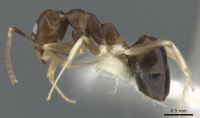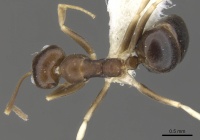Technomyrmex rector
| Technomyrmex rector | |
|---|---|

| |
| Scientific classification | |
| Kingdom: | Animalia |
| Phylum: | Arthropoda |
| Class: | Insecta |
| Order: | Hymenoptera |
| Family: | Formicidae |
| Subfamily: | Dolichoderinae |
| Genus: | Technomyrmex |
| Species: | T. rector |
| Binomial name | |
| Technomyrmex rector Bolton, 2007 | |
Nothing is known about the biology of Technomyrmex rector.
Identification
Bolton (2007) - A member of the Technomyrmex bicolor group. The posterior margin of the head in rector is more broadly, shallowly impressed in full –face view than in Technomyrmex kraepelini or Technomyrmex sundaicus workers of the same size. The median clypeal notch in rector is much more shallow than in those two species, where the maximum length of the notch in full-face view is usually at least 0.45 times the distance between the posterior margin of the notch and the clypeal suture, or obviously more. The right antenna of the rector holotype is missing and its gaster is abraded. No actual setae are present but the second and third tergites appear to have had only one pair of setae each. The fourth tergite is mostly telescoped within the third and no setae are visible on its surface, though they may have been lost. In workers of kraepelini and sundaicus with similar telescoping, flattened down setae remain obvious. The true setal pattern of the gaster in rector must await the discovery of fresh workers. Finally, the uniform light colour of the middle and hind tibiae and tarsi of rector is not duplicated in either kraepelini or sundaicus, where the tibiae are always distinctly darker than the tarsi.
Keys including this Species
Distribution
Latitudinal Distribution Pattern
Latitudinal Range: 32.6979° to 11.01833°.
| North Temperate |
North Subtropical |
Tropical | South Subtropical |
South Temperate |
- Source: AntMaps
Distribution based on Regional Taxon Lists
Oriental Region: India (type locality).
Distribution based on AntMaps
Distribution based on AntWeb specimens
Check data from AntWeb
Countries Occupied
| Number of countries occupied by this species based on AntWiki Regional Taxon Lists. In general, fewer countries occupied indicates a narrower range, while more countries indicates a more widespread species. |

|
Estimated Abundance
| Relative abundance based on number of AntMaps records per species (this species within the purple bar). Fewer records (to the left) indicates a less abundant/encountered species while more records (to the right) indicates more abundant/encountered species. |

|
Biology
Castes
Nomenclature
The following information is derived from Barry Bolton's Online Catalogue of the Ants of the World.
- rector. Technomyrmex rector Bolton, 2007a: 97, fig. 71 (w.) INDIA.
Unless otherwise noted the text for the remainder of this section is reported from the publication that includes the original description.
Description
Worker
Holotype. TL 3.5, HL 0.81, HW 0.78, SL 0.80, PW 0.53, WL l.08. Indices: CI 96, SI 103, or 28, EPI 74, DTI 138.
Head behind clypeus dorsum of mesosoma, declivity of propodeum and first gastral tergite all entirely lack setae. Gastral tergites 2 - 3 should each apparently have a single pair of stout setae present (see notes). Anterior clypeal margin with a broad, shallow median notch that is less than semicircular; the margins of the notch meet the lateral portions of the anterior margin through rounded curves, not sharp angles. In full-face view the maximum length of the notch is only about 0.25 times the distance from its posterior margin to the clypeal suture. Posterior margin of head broadly but shallowly Indented. With head in fullface view the outer margins of the eyes fail to touch the outline of the sides of the head; the sides convex. Scape index 103. Clypeal sculpture fine between posterior margin of notch and clypeal suture. In dorsal view the metathoracic spiracles are close to the metanotal groove; distance separating them is slightly greater than one spiracle diameter. Mesosoma with DTI 138. In profile the straight-line length of the propodeal dorsum is much less than the depth of the declivity to the spiracle. Dorsal outline of propodeum without a notch or indentation at about its midlength. In profile the head, mesosoma, petiole and gaster are uniformly brown. Anterior coxae brown but middle and hind coxae yellow and strongly contrasting with the mesosoma. All trochanters yellow. Middle and hind femora light brown for most of their length but yellow near apices. Middle and hind tibiae and tarsi all the same shade of yellow.
Type Material
Holotype worker, India: Coimbatore, 25.ix.1977 (J. Noyes) (The Natural History Museum).
References
- Bolton, B. 2007. Taxonomy of the dolichoderine ant genus Technomyrmex Mayr (Hymenoptera: Formicidae) based on the worker caste. Contributions of the American Entomological Institute. 35(1):1-149.
References based on Global Ant Biodiversity Informatics
- Bolton B. 2007. Taxonomy of the dolichoderine ant genus Technomyrmex Mayr (Hymenoptera: Formicidae) based on the worker caste. Contributions of the American Entomological Institute 35(1): 1-150.

